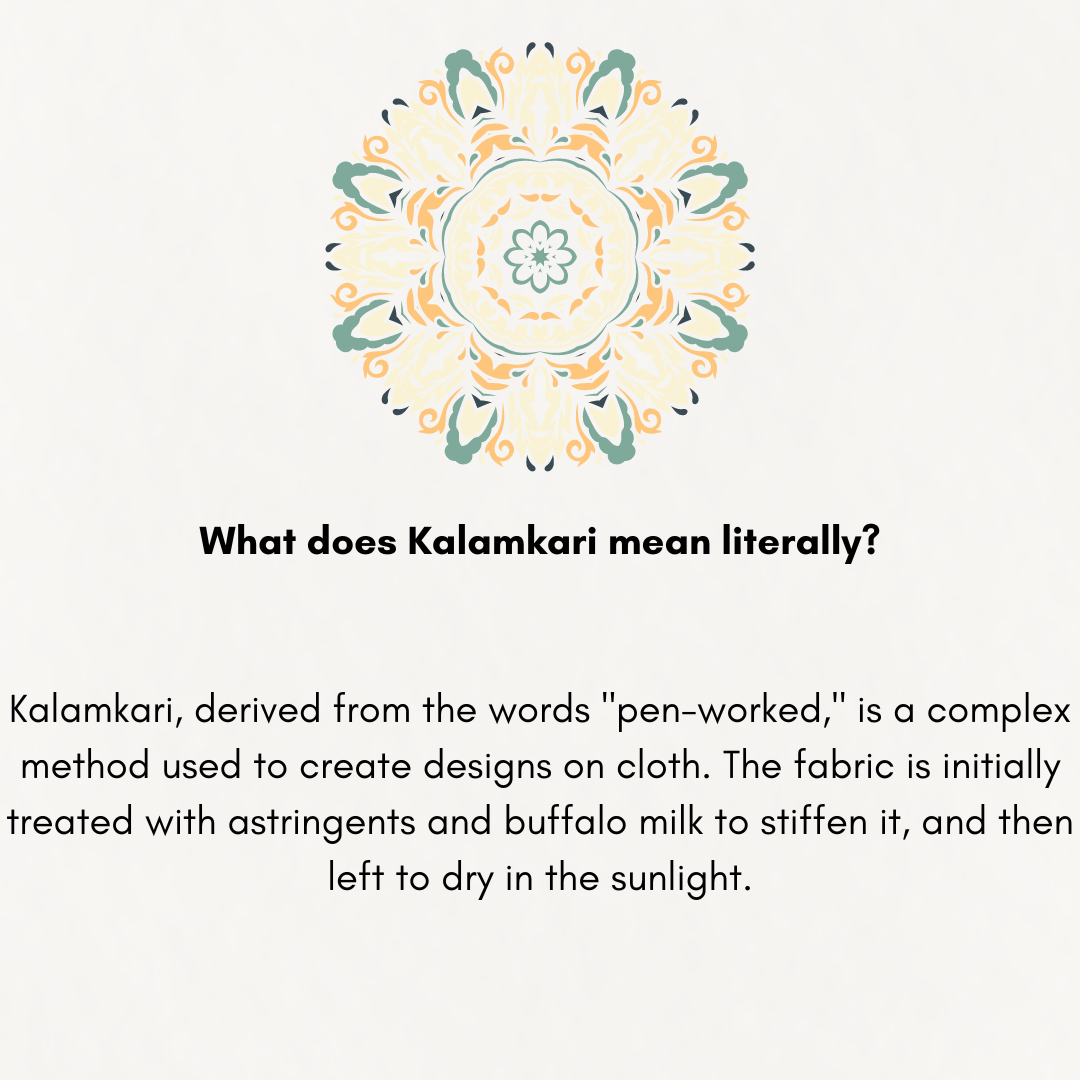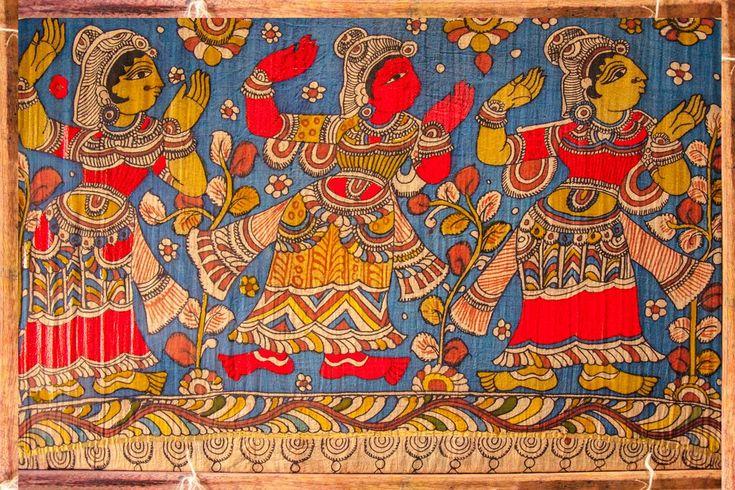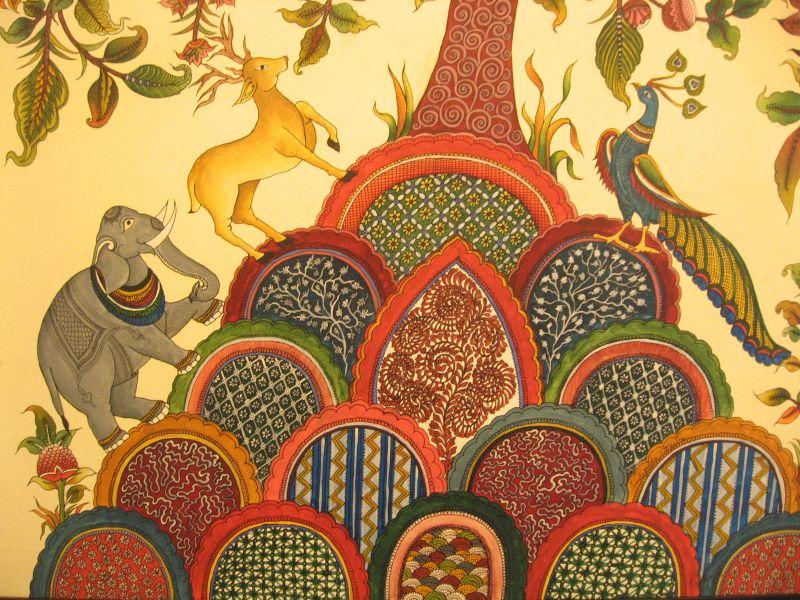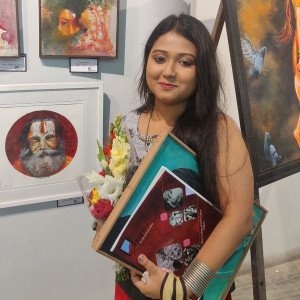When artists apply paint to any material—cloth, canvas, pottery, or anything else—their intention is not just to create a work of art that tells a story but also to leave a lasting legacy for future generations. In this regard, the traditional South Indian art of kalamkari, which combines hand painting and printing, is highly significant. Kalam, meaning pen, and Kari, meaning effort, are the roots of the word Kalamkari. The artists of Kalamkari used vegetable dyes to create vibrant paintings that featured mythical subjects, floral motifs, animals, birds, and trees of life. The architects and landscapes of Andhra Pradesh's temples, as well as the state's abundant natural resources, served as inspiration for the artists.

A combination of the words patta (cloth) and chitra (image) gave rise to the old name pattachitra, which kalamkari chitrakala was earlier known as. Stories from Hinduism, Jainism, and Buddhism were depicted in this style during the ancient and medieval periods. Kalamkari is more common in Andhra Pradesh and Telangana, whereas pattachitra is from Odisha.
The Golconda empire was a major patron of the Kalamkari art genre, which led to its peak and subsequent expansion. The use of only colours that can be found in nature is what makes Kalamkari paintings so intriguing.

History of Kalamkari
Musicians and artists called chitrakars would go from village to village reciting stories from Hindu mythology using huge pieces of cloth and paints made from plants and berries to depict the events. Original hand-painted Kalamkari artefacts can still be found in temples and museums to this day.

During the reign of the Mughals, the art form flourished; the sultanate of Golconda bestowed enormous support on the artists who practised traditional kalamkari, and they came to be known as Qualamkars. Several families in the village of Pedana, which is close to Machilipatnam, continue to practice this art form, making it a true home in the area.
Distinctive styles of Kalamkari art in India
There are two distinctive styles of Kalamkari art in India – Machilipatnam style and Srikalahasti style.
While several styles of this art form developed throughout time, the three most notable are the Machilipatnam style, the Srikalahasti style, and the Karrupur style. The Machilipatnam style, which is still one of the most famous forms of kalamkari painting, drew heavily on Persian influences because Golconda became the center of the artists' activity and the region was governed by Muslim rulers.
The prints were initially made using blocks and the finer details were filled in with pens. The majority of the Srikalahasti style's tales are pen-and-ink depictions of Hindu mythology, such as the Ramayana and other Hindu epics. Lastly, the lesser-known Karrupur style originated in the Thanjavur region of Tamil Nadu; it was primarily intended for use as cloth for royal attires and featured more gold brocade.
Marvel at the rich history of the royal style of Mysore paintings.
Kalamkari Painting Technique
There is a wide variety of 23 steps involved in this intricate art form. To begin, soak the fabric in a mixture of bleach and cow dung before using it. After a few hours in the solution, the cloth will take on a uniformly distributed off-white hue. Submerging the cloth in a mixture of Myrobalans and buffalo milk is the second stage. This ensures that the natural dyes applied to the fabric will not smear.
The next thing to do is to wash the cloth under a running water stream so the buffalo milk smell goes away. The fabric is washed twenty times in a row using the same method and then left to dry in the sun. Before painting, artists mark the fabric with motifs and designs. Kalamkari artists use natural colours they mix to fill in the designs and patterns.
The Kalamkars employ a "tamarind twig" as a writing implement to add intricate and delicate details. Lotus and peacock motifs sit with depictions of Hindu deities like Parvathi and Vishnu. The Hindu epics Ramayana and Mahabharata are also depicted in this vibrant art genre.
23 Steps of Kalamkari
What type of pen is utilized for Kalamkari art?
Following the tracing of the central figure with charcoal sticks, the artist employs a finely pointed kalam, also known as a bamboo pen, which is dipped in black kasimi liquid. The kalam is encased in wool to retain the liquid, and the artist presses the wool to dispense the ink while painting. Once the black outline has dried, the artist can proceed to apply a mordant with alum and start adding red color to the fabric.
Colors of Kalamkari Art
Natural, organic colours, like mustard, indigo, green, black, and green, predominate in this style of art. Without the use of any synthetic or chemical substances, the natural dyes utilized in the painting process are derived solely from natural resources. Mixing jaggery, iron fillings, and water yields the black pigment for the Kalamkars. It is common practice to utilize black as an outline colour for the drawings.
In contrast to the red that is made from algirin or madder tree bark, mustard yellow is made by boiling pomegranate peels. Indigo is the source of blue, while a combination of blue and yellow yields green. Demons are represented in various shades of green and red, while holy deities and heavenly things are depicted in blue. Lotus themes are used as backgrounds for this art form most of the time.
Themes and Motifs in Kalamkari Paintings
Themes inspired by nature and floral designs coexist with religious figures, mythological tales, and epic scenes from the Mahabharata and Ramayana in Kalamkari paintings. Each piece of art is a reflection of spirituality and cultural heritage because of the spiritual and symbolic meanings embedded in the subjects.


Types of Kalamkari Paintings
Srikalahasti, from the Chittoor district, and Machilipatnam, from the Krishna district, are two varieties of Kalamkari paintings. Freehand drawing is the Srikalahasti style, whereas block printing is the Machilipatnam style. Each style is special in its own way, and they both choose beautiful saree patterns.
Machilipatnam Kalamkari
In contrast to Machilipatnam Kalamkari, which evolved out of the need to trade with other nations, Srikalahasti Kalamkari has religious origins. This is an interesting detail regarding Machilipatnam Kalamkari.
The distinctive block-printed designs of Machilipatnam Kalamkari are easily recognizable. These blocks have elaborate wood carvings that were filled in using vegetable dyes. The block-printed patterns of Machilipatnam kalamkari sarees, which showcase their exquisite patterns and immaculate prints, have gained global fame.
Srikalahasti Kalamkari
Singhania is known for her exquisite Srikalahasti kalamkari sarees. We are completely smitten with Srikalahasti Kalamkari sarees. The intricate hand-painted patterns and scenes are sure to turn heads.
The root words of the name "Kalamkari" are "Qalam" (pen) and "Kari" (craftsmanship) in Persian. In kalamkari painting, the tool known as a kalam is a bamboo reed pen that is covered with cloth and fastened with cotton thread. The two most common kinds of kalams are the one used for outlining and the one used for colouring.
Exquisite and mesmerizing kalamkari patterns adorn a handpainted saree. Legend has it that scenes from sacred texts like the Bhagavatam, the Mahabharata, and the Ramayana were the original subjects of Kalamkari's artistic expression. The kalamkari saree, a 6-yard-long canvas dyed with earthy colours, allows the artist to express his ideas.
Interesting Facts about Kalamkari Indian Folk Art
- A healing aura is created by the colors, motifs, compositions, and narration of magical forms in Kalamkari, which is why it is also known as a healing fabric.
- In ancient times, groups of artists, musicians, and storytellers known as Chitrakattis travelled from village to village, sharing the great myths and legends of Indian mythology with the locals. This cloth is famous for being multi-cultural, which is an extremely unique quality in and of itself.
- From the most intriguing temple walls, the British in the 18th century took an interest in the ornamental aspect and applied it to garments, rebranding it as "Fabric for Fashion." Ever since then, Kalamkari has served as a global source of inspiration for countless materials.
- The Machilipatnam style, which was popular with the Golconda kings, is characterized by a greater emphasis on natural themes, such as flowers, leaves, and the sun, in contrast to the Srikalahasti style, which is heavily adorned with Hindu symbols.
- Two words—"kalamkari" and "chintz"—led to a ban on cotton imports to England. English millowners suffered enormous losses when the East India Company exported chintz, a fabric inspired by kalamkari which means "spotted," to France and England. Throughout Europe, this was a huge problem from the 1680s until the 1740s. Later on, England, France, and Spain all outlawed imported cotton. Because of this, mills were mechanized, which was a major factor in the Industrial Revolution.
- Among the top three countries that import Kalamkari goods from India, the US accounts for over 85% of the total, followed by Italy and Nepal.
- In recent years, the Buddha motif has grown in popularity. Although kalamkari is mentioned in older Buddhist writings, the current design of the Kalamkari Buddha can be influenced by market trends.

Kalamkari has gone a long way from its early days as sacred paintings of Indian gods and goddesses to its rise to prominence under the Mughal era and, finally, to its current status as the art form's most prolific creator in Andhra Pradesh. The painstaking procedure needed in manufacturing Kalamkari art has caused it to lose its vibrant appeal in the past decade. This art form was already on the decline until high-tech machine looms and printed fabrics came along. However, it was the Indian fashion industry's designers who banded together to support artisans in Andhra Pradesh who were reviving this art form.
Unravel the history of South India's oldest style of painting, the Tanjore style.
Most Famous Kalamkari Paintings In India & Artist Name List
Most Famous Kalamkari Paintings
- Kalamkari Panels Depicting Hindu Mythology
- Kalamkari Tree of Life
- Pattachitra Style Kalamkari
- Floral and Paisley Designs
Notable Kalamkari Artists
- Kandi Narsimha Reddy
- Padma Shri J. Gurappa Chetty
- Narayan Reddy
- Vasudeo Kamath
- S. Chandra Mouli
- Parashuram Kalahasti
- Ganga Devi
- Sarika Devi
Kalamkari art is a cherished part of India’s cultural heritage, with numerous artists contributing to its preservation and evolution. From traditional depictions of Hindu mythology to contemporary interpretations, these paintings continue to captivate art enthusiasts. Renowned artists like Padma Shri J. Gurappa Chetty and Kandi Narasimha Reddy have played significant roles in maintaining the rich legacy of this exquisite art form.
What are your thoughts about Kalamkari paintings?
















